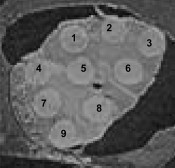 Young G. Shin, Teresa Dong, Bilin Chou and Kapil Menghrajani
Young G. Shin, Teresa Dong, Bilin Chou and Kapil Menghrajani
Arch Pharm Res. (2011),34 (11), 1983-1988
Recently matrix-assisted laser desorption/ionization mass spectrometry (MALDI MS) imaging has been used to analyze small molecule pharmaceutical compounds directly on tissue sections to determine spatial distribution within target tissue and organs. The data presented to date usually indicate relative amounts of drug within the tissue. The determination of absolute amounts is still done using tissue homogenization followed by traditional liquid chromatography-tandem mass spectrometry (LC-MS/MS). In this study, the quantitative determination of loperamide, an antidiarrheal agent and a P-glycoprotein substrate, in mdr1a/1b (-/-) mouse brain tissue sections using MALDI MS on a quadrupole time-of-flight mass spectrometry is described. 5 mg/mL α-cyano-4-hydroxycinnamic acid in 50% acetonitrile with 0.1% trifluoroacetic acid and 0.5 μM reserpine was used as the MALDI matrix. The calibration curve constructed by the peak intensities of standard samples from MALDI MS was linear from 0.025 to 0.5 μM with r(2) = 0.9989. The accuracy of calibration curve standards was 78.3-105.9% and the percent deviation was less than 25%. Comparison between direct MALDI tissue analysis and conventional tissue analysis using homogenization followed by electrospray LC-MS/MS was also explored.


No responses yet